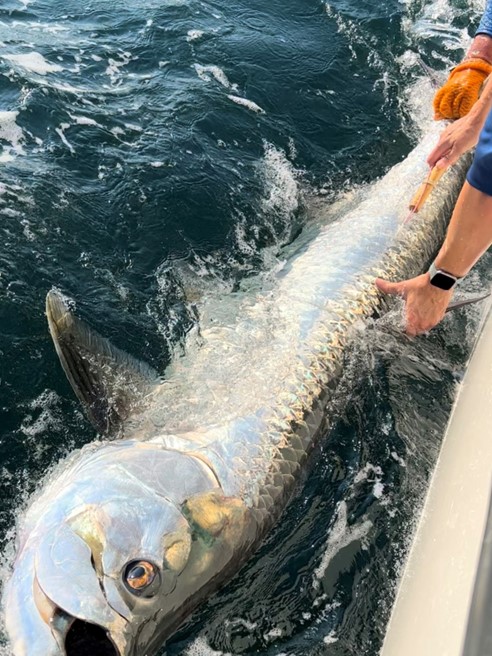Scientists turn to tracking technology to figure out tarpon migration patterns in the northwestern Gulf of Mexico.


By Shane Stephens
TIDE
April/May 2023
Tarpon are among the most intriguing of sportfish, fusing stamina and explosive power into an addictive combination that can turn ordinary anglers into lifelong fanatics. Capable of growing to more than 8 feet in length and weighing several hundred pounds, this acrobatic fish known as the “silver king” has irresistible appeal to a growing army of saltwater enthusiasts.
Although it is almost exclusively a catch-and-release fishery, increased fishing pressure and nursery habitat loss, often caused by coastal development and altered freshwater sources, have caused tarpon to be classified as “vulnerable” by some organizations. Effective and informed conservation efforts and regulations are needed to better protect the species and rebuild populations to historical levels.
Tarpon are a highly migratory species capable of long-distance movements, often traveling hundreds of kilometers during annual seasonal migrations. Migratory pathways displayed by tarpon often cross state and even international management boundaries, resulting in a shared population that is exposed to different levels of protection throughout its range. Currently, tarpon regulations in the recreational fishery differ significantly among coastal states in the U.S., ranging from no regulations to completely catch-and-release practices with additional rules for handling larger individuals.
Previous studies have observed adult tarpon making seasonal migrations, typically moving north as water temperatures warm in the spring and summer and moving south in the fall and winter. Research on tarpon off the Florida coast has been underway for several decades; however, more limited efforts have been conducted on tarpon in the northwestern Gulf of Mexico and the population status and migration patterns of fish off Texas remains a bit of a mystery. Current research being performed at the Fisheries Ecology Lab at Texas A&M University at Galveston (TAMUG) aims to gain a better understanding of the habitat requirements and population connectivity of tarpon inhabiting the northwestern Gulf of Mexico using acoustic telemetry.
TAG AND TRACK
Acoustic telemetry uses electronic acoustic transmitters or tags placed on or within the body of an individual, to track the movements of fishes as they are detected on acoustic receivers which are stationary listening devices. Acoustic telemetry has recently become a leading method for tracking and movement studies, once dominated by satellite tagging, due to the lower cost per tag, small tag size, and relatively long battery life of up to five years. The size of the tag also provides the opportunity to internally place the tag via surgery, allowing for the potential of longer retention times.
The ongoing tarpon research at TAMUG utilizes a large number of stationary acoustic receivers placed in coastal waters off Texas and Louisiana. This coastal array of receivers serves as “acoustic gates” that detect any acoustically tagged tarpon moving along the coast. With the help of local captains, we have tagged 44 tarpon over the past few years. The tarpon enthusiasts assisting us are passionately interested in protecting this fascinating species for future generations and have been vital in the tagging effort by allowing research scientist to come along on trips and acoustically tag tarpon that were caught before being released.
Acoustic tags for this study were all surgically implanted by making a small incision, just large enough for the tag to be placed internally inside the body cavity of the tarpon. An additional spaghetti tag or conventional tag was then placed near the dorsal fin and contains an ID number as well as the Fisheries Ecology Lab’s contact information that can be reached if the fish is recaptured. After the tagging process is complete, the fish is revived and released.
TWO GULF STOCK STRUCTURES
Acoustic detection data for tarpon tagged during our study indicate that tarpon present in waters from Galveston to Port O’Connor, Texas, undertake seasonal migrations and show site fidelity, often returning to same areas each year. Seasonal migrations start in the late summer and fall with individuals moving south, and this is followed by a return migration to our original tagging locations the following summer.
These migrations are commonly believed to be driven by temperature changes, but they are also linked to prey availability and spawning. We also observed that tarpon tagged east and west of the Mississippi River Delta displayed conspicuously different migrations patterns and none of our tagged individuals moved across this geographical feature and into the other zone. This suggests the presence of two migratory contingents in the Gulf of Mexico, with the eastern and western migratory contingents wintering in Florida and South Texas/Mexico, respectively.
The presence of two unique stock structures in the Gulf of Mexico would need to be accounted for when forming management practices and conservation efforts. With the opening of the Gulf Research Institute for Highly Migratory Species at Texas A&M University in Galveston, research on tarpon will continue to shed additional light on the life history and population structure of tarpon in the Gulf of Mexico. Additionally, the Institute is planning future studies on juvenile tarpon found along the Texas coast to identify critical nursery habitats and environmental conditions that support the successful survival and recruitment of tarpon.
For more information regarding current research on tarpon or other exciting research projects on gamefishes, visit the Fisheries Ecology Lab’s website at www.tamug.edu/rooker. If you are interested in learning more about the research on highly migratory species found in the Gulf of Mexico conducted by The Gulf Research Institute for Highly Migratory Species and information on how to get involved, you can visit www.tamug.edu/grihms/.
Shane Stephens is a Master’s student at Texas A&M University at Galveston Fisheries Ecology Lab. In 2020, he was selected for a CCA Science of Conservation scholarship funded by bp to continue his academic work on small- and large-scale connectivity of marine fishes. His research uses acoustic telemetry and satellite tags in order to observe migrations of tarpon along the Texas coast to better understand timing and migration pathways.








